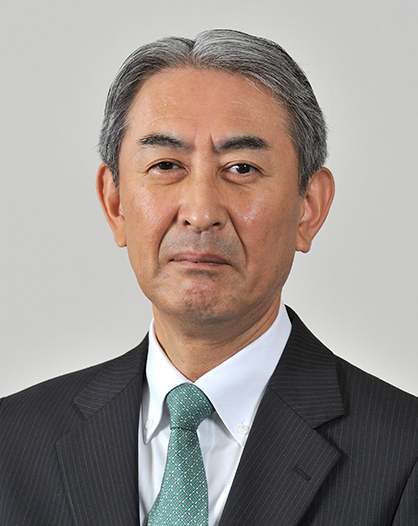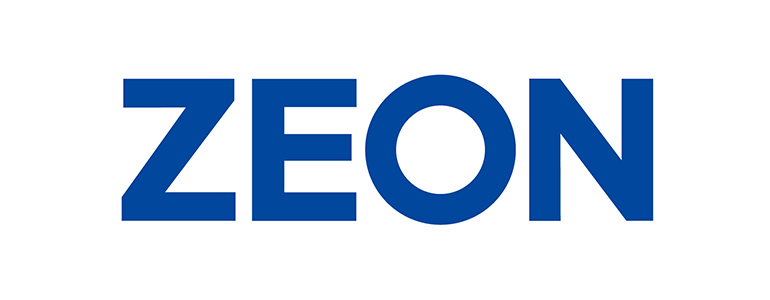| ZEON CORPORATION (4205) |
|
||||||||
Company |
ZEON CORPORATION |
||
Code No. |
4205 |
||
Exchange |
TSE 1st Section |
||
Industry |
Chemicals |
||
President |
Kimiaki Tanaka |
||
HQ Address |
Marunouchi 1-6-2, Chiyoda-ku, Tokyo |
||
Year-end |
March |
||
URL |
|||
* Share price as of closing on November 11, 2016. Number of shares outstanding as of most recent quarter end and does not include treasury shares.
ROE and BPS from the last year-end. |
||||||||||||||||||||||||
|
|
* Estimates are those of the Company. Net income is net income attributed to parent shareholders.
|
| Key Points |
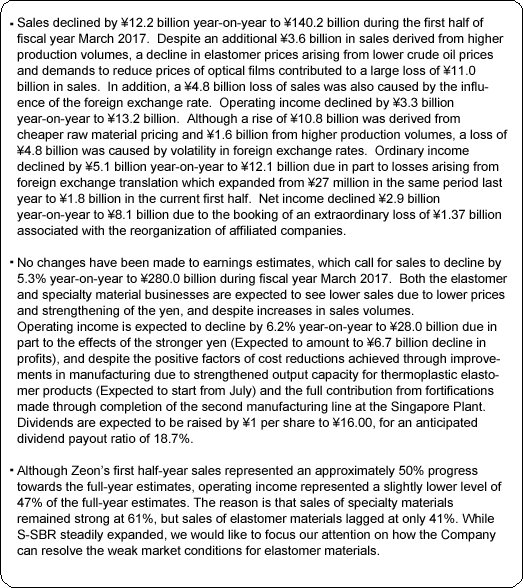 |
| Company Overview |
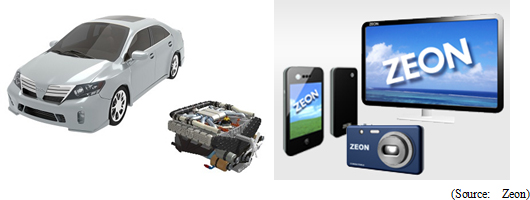 (Company Name and Management Vision)
The company name "Zeon" is derived from the Greek word for earth "geo" (phonetically pronounced "zeo" in Japanese) and the English word reflecting eternity "eon," and reflects the Company's principle of "deriving raw materials from the earth and perpetually contributing to human prosperity" through the development and application of creative technologies. (Zeon's original name "Geon," used at the time of its establishment, was derived from the trademark acquired for the vinyl chloride resin "Geon" from the Goodrich Corporation (then called B.F. Goodrich Company) in the United States, with which it had capital and collaborative technological agreements. The company name was changed to "Zeon" when the capital agreement was dissolved in 1970.)
(Corporate History)
Zeon was established as a joint venture company formed by the Furukawa Group companies Nippon Light Metal Co., Ltd., Furukawa Electric Co., Ltd., and Yokohama Rubber Co., Ltd. in April 1950 to acquire and use the vinyl chloride resin technology from B.F. Goodrich Chemicals Co. In 1951, Goodrich acquired 35% of the shares of Zeon for full-scale technological and capital partnership, and in 1952 mass production of vinyl chloride resin began in Japan for the first time. In 1959, Goodrich transferred synthetic rubber manufacturing technologies to Zeon, which, in turn, started Japan's first mass production of synthetic rubber. Manufacturing facilities were also expanded to match the growing demand for tires and other automobile parts. In 1965, use of the Company's unique technology called Geon Process of Butadiene (GPB) for the efficient manufacture of butadiene (main raw material of synthetic rubber) from C4 fraction was operational.Goodrich transferred its specialty synthetic rubber business to Zeon along with the shift in its main business focus toward vinyl chloride resins. Capital ties were dissolved in 1970. Along with these changes, the Company name was changed from Geon to Zeon in 1971. Also in 1971, Zeon developed a unique technology called Geon Process of Isoprene (GPI) and began using it to manufacture raw materials including high-purity isoprene, petroleum resins, and synthetic perfume ingredients from C5 fraction. After entering the 1980s, Zeon aggressively launched new businesses in various fields including photoresists and other information materials, and medical-related applications in addition to its main synthetic rubber business. In 1984, production of hydrogenated nitrile rubber Zetpol®, which currently has top share of the worldwide market, began at the Takaoka Plant. In 1990, manufacture of synthetic cyclo-olefin polymer resin (COP) ZEONEX®, which is the main product of the specialty material business using the GPI method to extract and synthesize products, was started at the Mizushima Plant. In 1993, Zeon entered China with its electronics materials business. In 1999, Zeon Chemicals L.P. (Consolidated subsidiary in the United States) acquired the special rubber business of Goodyear Tire & Rubber Company of the United States to become the world's top manufacturer of specialty rubber. In 2000, Zeon discontinued production of vinyl chloride resins at the Mizushima Plant, and thus withdrew from the Company's founding business. In 2002, ZeonorFilm™ was launched as a liquid crystal display (LCD) use optical film. Zeon Chemical Singapore Pte. Ltd. and Zeon Korea Co., Ltd. were founded, in 2010 and 2011 respectively, as part of the strategy to fortify Zeon's global production and sales structure. In March 2013, a takeover bid of TOHPE CORPORATION was completed and Tohpe became a fully-owned subsidiary.In September 2013, the plant for S-SBR in Singapore was completed and started commercial operation. In February 2015, Zeon enhanced capacity of optical film for LCD in Himi City, Toyama prefecture. In November 2015, Zeon started the world's first mass production of "super growth carbon nanotube". (Business Description)
Zeon's main products use various extracted from naphtha, which is extracted by distillation of crude oil. Zeon uses butadiene extracted in the GPB method developed in-house from C4 fraction after extracting propylene (C3), isoprene monomer (IPM) extracted from C5 fraction using the GPI method, high-boil monomer (HB), dicyclopentadiene (DCPD), and 2-butyne as raw materials to be processed into synthetic rubber, synthetic latex and various other materials. 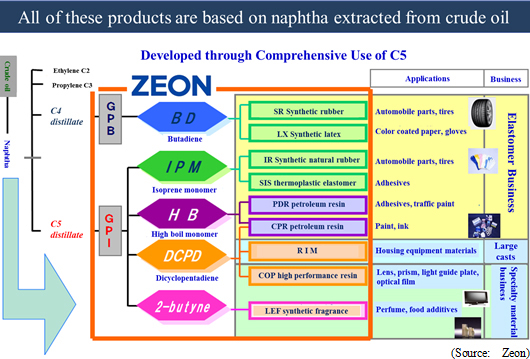 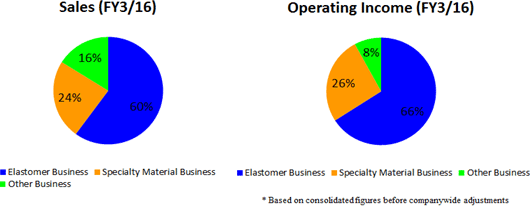 <Elastomer Business>
Elastomers are "high molecular compounds that have rubber-like elastic properties," an example of which is synthetic rubber. As described in the corporate history section of this report, in 1959 Zeon became the first company in Japan to mass-produce synthetic rubber, which became the foundation underlying all of Zeon's businesses. This business can now be divided into synthetic rubber, synthetic latex, and chemical products (petroleum resins, thermoplastic resins) businesses.
①Synthetic Rubber Business
<Example of final product : Tires>Zeon provides the world's leading tire manufacturers with the world's highest-quality synthetic rubber for use in tires. Among the various types of synthetic rubber manufactured are styrene butadiene rubber (SBR), which promotes superior abrasion resistance, aging resistance and mechanical strength properties, butadiene rubber (BR), which includes a superior balance between elasticity, wear and low-temperature properties, and isoprene rubber (IR), which features similar high levels of quality, consistency and other properties as natural rubber. In the future, S-SBR for energy-saving tires which has improved characteristics from existing SBRas demand is expected to rapidly expand, and capacity is expected to be increased along with the Singapore plant, which started operation in September 2013. Consequently, supply capacity rose during the first stage by 30,000 to 40,000 tons per year in September 2013, and is expected to rise in the second stage from the second half of 2016 by another 30,000 to 40,000 tons from September 2013's level of 55,000 tons per year. 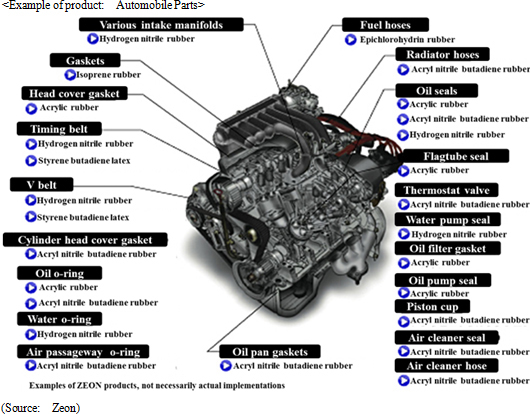 Furthermore, a new grade of Zetpol® has vastly improved the performance of products using the original versions of Zetpol®. Products using the new grade of Zetpol® are heat resistant at temperatures that exceed the limits for the original version of Zetpol® by 15 degrees centigrade, thereby extending the life of seals and gaskets, and are in strong demand for use in next generation bio-fuel engines. The new grade of Zetpol® is well suited to extrusion processing which is being leveraged to expand its usage in various hoses. Products using Zetpol® have also been well received by customers, and are being used increasingly as a replacement material for more expensive competitive rubber in Japan, Asia, Europe and North America. Commercial production of the new Zetpol® started in November 2012 at Zeon's Kawasaki Plant and reached full-scale production in 2013. ②Synthetic Latex Business
Synthetic latex is basically synthetic rubber dispersed in water to form liquid rubber and is used to manufacture gloves, processed paper, textile processing, adhesives, paints, cosmetic puffs and other products. Zeon has close to 90% share of latex used in cosmetic puffs.
③Chemical Products Business
Zeon uses its unique in-house GPI method to turn C5 fraction into adhesive tapes, hot melt adhesive use materials, traffic paint binder and a wide variety of other products.
<Specialty Material Business>
Research and development activities are being promoted for the "realization of an advanced information society," "saving, storing, and creating energy," and "enhancing in quality of life." Furthermore, specialty materials produced by Zeon are used in "TI components," "energy materials," and "medical devices," which are targeted as three key business areas.
①IT Components
Cyclo-olefin polymers are thermoplastics resins developed by Zeon's own unique technologies using extracted C5 from its GPI methods. The commercial products include ZEONEX® and ZEONOR®.ZEONEX® leverages its superior optical properties for use in compact lenses for cameras of cellular telephones, and as optical parts used in printers, like optical pickups, and mirrors. ZEONOR® leverages its high transparency, transcription capabilities in molding, and heat resistance to be made into transparent general use engineering plastics for use in lighted panels, automobile parts, containers, discs and a wide range of applications. ZeonorFilm™ is optical film made from cyclo-olefin polymerusing the world's first melt extrusion manufacturing process for applications in LCD televisions, and is used in smartphones, tablet PCs, and is expected to be used in digital signage and a wide range of other products in the future. 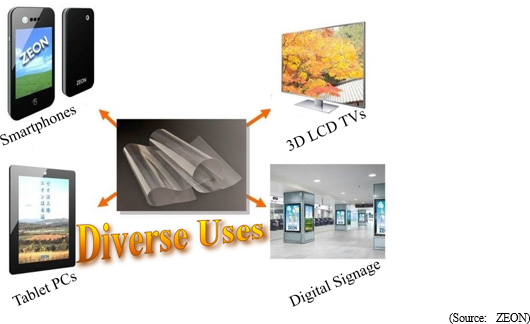 The use of organic EL in reflective light-protective film is progressing, and demand for small- to medium-sized flat panel display applications is expected to grow in the future. In addition to the current plants in Takaoka and Himi (an annual output of 15 million square meters for diagonally-stretched optical film in total), the construction of a new plant in Tsuruga, Fukui Prefecture was completed in October 2013. ZEOCOAT® applied organic insulation film is also used in cellular telephones, smartphones, and LCD televisions. ZEOCOAT® was successful in improving both the picture quality and reliability of displays because of its high transparency, extremely low water absorption and low gas generation properties. In the future, Zeon will aggressively expand its marketing efforts for organic EL displays because they can be made thinner than LCD displays, and to thin membrane transistors using new semiconductors and insulating materials for flexible displays. ②Energy Materials
Lithium ion batteries are a key component in mobile devices (smartphones, tablets, notebook PCs), wearables, energy storage systems (ESS) and electric vehicles (EV). Zeon materilas have been broadly adopted for lithium ion batteries since Zeon first launched water-based anode binder in 1995.Today, Zeon has market leading share for anode binders, cathode binders, functional layer materials, and sealant materials for lithium ion batteries. Zeon materials have been developed to help battery makers and OEMs overcome technical hurdles including high energy density and high voltage for smartphone batteries and poor cycle life at high temperature for ESS and EV batteries. Zeon's advancements for lithium ion cells include: 1. Water-based cathode binder for increased cycle performance under high voltage
2. Water-based anode binder for improving cell capacity by 5~15%3. Functional layer materials to improve the safety and durability of separators. Zeon leverages its corporate expertise in polymer design, its extensive capability for electrochemical and analytical testing, and its more than 20 years of experience supplying into the lithium ion battery market to continuously optimize and develop the materials needed for current and next-generation applications, including fast-charging. 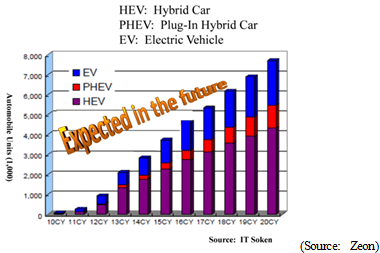 ③Medical Device
The medical device market is relatively well insulated from fluctuations in the economy, and is anticipated to grow with the aging society in Japan and expansion in developing countries. Furthermore, medical device companies are subject to strict laws and regulations, and they need to submit approval applications to regulatory bodies. In addition, the need to develop relationships with healthcare professionals is critical and the subsequent high barriers to entry make this a highly attractive market.Along with the start of development of artificial kidneys in 1974, Zeon aggressively promoted its medical device business. In 1989, a subsidiary called Zeon Medical Inc. was established to conduct development, manufacturing, sales and all other functions of the medical field for the Zeon Group. Zeon has shown bountiful development track record with "offset balloon catheter" as a means of differentiation in the gallstone removal process and with Japan's first biliary covered stent "Zeostent Covered" in the area of gastroenterology products, and the world's smallest diameter "XEMEX IABP Balloon PLUS" as a device to aid the heartbeat at times of acute myocardial infarction in the area of cardiovascular products. 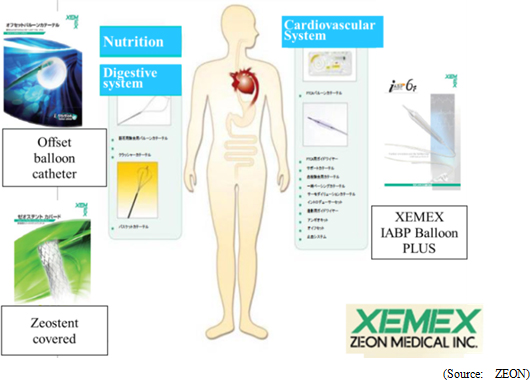 In March 2016, the Company launched the world`s first optical sensor FFR device as a type of guide wire. Because it uses an optical fiber sensor, mistaken readings of blood pressure measurements rarely occur. Zeon is aiming for a 30% share of the Japanese market by 2020. ④Petrochemical Products Business
Zeon deals in specialty chemicals including synthesized fragrances used in foods, fragrances and cosmetics that use ingredients derived from C5 fraction, and solvents and vegetation conditioning agents. The Company also holds the world's top share of the ecological synthesized fragrances, and provides a wide range of specialty products including ingredients for intermediary bodies used in medical and agricultural chemicals, fluorocarbon replacement solvents, cleaning agents, urethane expanding agent, and functional ether agents.
①What is Single-Walled CNT?
In 1993, Sumio Iijima, Ph.D., head of the Applied Nanotube Research Center of the National Institute of Advanced Industrial Science and Technology (AIST), discovered a cylindrical nanostructure that was able to form a beehive lattice of carbon atoms for the first time in the world, which he named "Carbon Nanotubes (CNTs)." CNTs can be divided largely into single-walled and multiple-walled CNTs. Multiple-walled CNT is relatively easy to manufacture and applied development is being promoted within Japan for commercial applications.
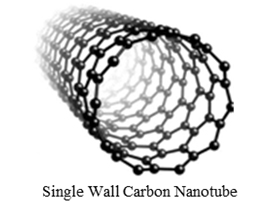 - 20 times stronger than steel - 10 times more heat conductive than copper - Half as dense as aluminum - 10 times the electron mobility of silicon Consequently, single-walled CNT is superior to multiple-walled CNT because it is "lightweight but highly flexible" and has "extremely high electric-and heat-conductivity" properties. CNT is believed to have applications as an electrical conductivity assistance agent in lithium-ion batteries, as transparent conductive film used in electronic paper and ultra-thin touch panel because of its high elasticity and strength, and as a heat dissipating material. And because of its ability to absorb a wide spectrum of light, practical applications of single-walled CNT are being promoted in the area of electromagnetic wave absorbing materials for use in a wide range of fields including energy, electronics, structural materials, and specialty materials. 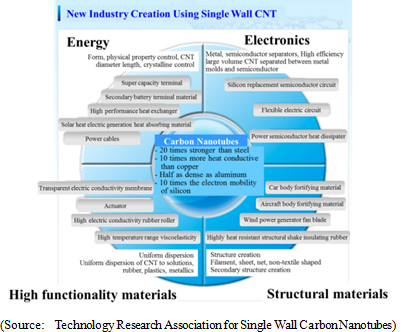 ②Zeon's Efforts and Position
Against this backdrop, the AIST and five companies, namely Zeon, NEC Corporation, Toray Industries, Teijin Limited, and Sumitomo Precision Products Co., Ltd., jointly established the "Technology Research Association for Single-Walled Carbon Nanotubes" technological consortium in May 2010. The consortium aims at establishing technologies that are necessary for the commercialization of new products using single-walled CNT developed in Japan with its numerous superior qualities in response to the worldwide social demands to realize a low-carbon society. Using the synthesizing technology developed by Dr. Kenji Hata (Ph.D.) of the AIST as a base, the above-mentioned consortium has been conducting research and development for mass production and application development for compound materials at a validation plant that was established in December 2010 on the premises of the Tsukuba Center of the AIST. Among the main reasons that the AIST Nanotube Applied Research Center selected Zeon to become its partner were the impressive track record and results obtained by Kohei Arakawa, Zeon's former Managing Director, as a researcher in CNT research and development. Furthermore, the fact that the consortium director is Zeon President Furukawa reflects the importance of Zeon in this project to realize commercial applications of single-walled CNT. ③Future Endeavors
Having established the technology necessary for mass production based on the method called "super growth", Zeon completed the CNT production facility and started mass production, the first in the world in November 2015 in its Tokuyama plant at Shunan-city, Yamaguchi Prefecture.Zeon is the only company in the world that has established mass production technologies for single-wall CNT, and requests for product samples have been received from about 100 Japanese and foreign companies, in addition to those within the consortium mentioned above. Consequently, shipments of samples have already begun. Moreover, Zeon has already begun to propose practical applications of this product. At the same time, single-wall CNT is a type of nanomaterial that is extremely small in size and takes the form of textile. Therefore, there are some fears that it may have some impact upon biological processes depending upon its size and shape. Currently, the AIST is conducting standardization of the evaluation process, and activities for the OECD endpoint measurement are being conducted, with global standardization and legal and regulatory aspects being considered. <Other Business>
The combination liquid for Reaction Injection Molding (RIM) and molded items using the ingredient dicyclopentadiene (DCPD) as a raw material.
(Characteristics and Strengths)
1. World's Leading Creative Technology Development Capability
The GPB method used to manufacture butadiene from C4 fraction is the most important development in Japan's postwar history of chemicals, and is provided to 49 plants in 19 countries around the world.In addition, the Mizushima Plant is the world's only plant with GPI method to extract high-purity isoprene and other effective substances from C5 fraction. This GPI method is created by Zeon, and is a completely unique technology which is not provided to other companies. Zeon is able to acquire basic ingredients used in synthesized fragrances and petroleum resin. These two technologies represent the creative technological capabilities that are among the strengths of Zeon. They also are highly regarded by customers around the world and have received numerous awards within Japan and in overseas markets. With regard to technologies, Zeon has received 48 awards since 1960 for its GPB and GPI methods, in addition to 26 awards since 1982 for its environment conservation and safety efforts. 2. High Profit Margins
While Zeon ranks below other chemical manufacturers as shown in the graph below in terms of sales, it enjoys one of the highest operating income margins within the industry.
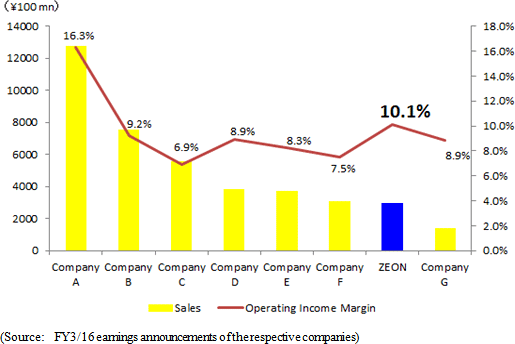 3. High Worldwide Share
Zetpol®, ZEONEX®, and ZEONOR® are representative of the products born from Zeon's highly creative technologies, which have allowed it to acquire high shares of worldwide markets. In addition to these products, Zeon also maintains the world's top share in "leaf alcohol" used in cosmetics and food flavorings, "polymerization method toner" printer toner manufactured using suspension polymerization method, and "ZEORORA®" used in semiconductor etching gas.
4. Research and Development Structure that Continues to Yield Creative Technologies
Zeon seeks to conduct research and development activities based upon its basic corporate philosophy of "developing creative technologies in special fields of strength that enables Zeon to contribute to society by generating the world's leading businesses."The Company's main R&D center is located in Kawasaki City, Kanagawa Prefecture. But because of the potential for more efficient research and development activities to be conducted closer to the manufacturing sites, Zeon has also established the Precision Optics Laboratory and Medical Laboratory at the Takaoka Plant, and the Chemical Product Research Facility at the Yonezawa Plant. In addition, research groups have been established in overseas markets including the United States and United Kingdom. Researchers must never be satisfied with current conditions, and should always be reminded of the threat that their competitors pose in their research activities. Furthermore, Zeon bases its valuation on a positive point awarding system that places high priority -on speed and creativity. R&D expenses were formerly measured as a percentage of sales, but for the future it has established an annual value amount of ¥12.0 billion as an investment budget to ensure that stable research and development activities can be maintained in the future. |
| First Half of Fiscal Year March 2016 Earnings Overview |
 Despite an Increase in Sales Volumes, Lower Prices and Strong Yen Contribute to Lower Sales and Profits
Sales declined by ¥12.2 billion year-on-year to ¥140.2 billion. Despite a ¥3.6 billion increase in sales derived from higher production volumes, a decline in elastomer prices arising from lower crude oil prices and demands to reduce prices of optical films contributed to a large ¥11.0 billion loss of sales. At the same time, a ¥4.8billion loss of sales was caused by the influence of foreign exchange rates. Operating income declined by ¥3.3 billion year-on-year to ¥13.2 billion. Although a rise of ¥10.8 billion was derived from cheaper raw material pricing and ¥1.6 billion from higher production volumes, there were price declining factors in the amount of ¥11 billion (¥7.2 billion from elastomer, ¥3.7 billion from specialty materials), in addition to a loss of ¥4.8 billion caused by volatility in foreign exchange rates. Ordinary income declined by ¥5.1 billion year-on-year to ¥12.1 billion due in part to a loss from foreign exchange translation which expanded from ¥27 million in the same period last year to ¥1.8 billion in the current first half. Net income declined ¥2.9 billion year-on-year to ¥8.1 billion due to the booking of an extraordinary loss of ¥1.37 billion associated with the reorganization of affiliated companies. 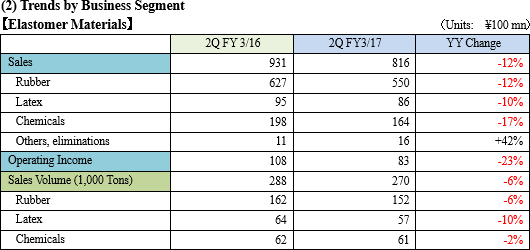 Tire use rubber sales volumes declined by 4% year-on-year. Domestic sales fell by 10% year-on-year due in part to the reduced tire production within Japan by tire manufacturers. Tire use rubber sales for exports rose by 1% year-on-year. Demand for S-SBR continued to trend favorably, with sales within Japan and exports rising by 6% and 19% respectively. Domestic sales of specialty rubber declined by 9% year-on-year, and exports fell by 13% due to deteriorating market conditions, avoiding the single-minded pursuit of sales volume growth. The share of specialty rubber sales to overall sales declined by 1% point year-on-year in volume terms to 31%, and by 1% point also in value terms to 57%.Latex sales volume decreased by 10%. Although demand for both reformed resin and general industrial use applications trended weakly, the completion of inventory adjustments for gloves in the first quarter allowed second quarter demand to trend favorably. Regarding chemical products, the production volume of thermoplastic elastomer grew by 10% on the back of an expansion in capacity, while petroleum resin decreased by 8% in volume terms.  In the specialty chemicals division, exports of battery materials grew by 46% compared to the previous term and contributed to an increase in overall sales despite a decrease of 1% year-on-year in electronic materials. With regards to chemical products, sales of fragrances rose 9% year-on-year, while toner sales decreased 19% year-on-year due to paperless trend. In the specialty resins division performed weak, with demand for optical films remaining flat and COP resins falling 6% compared to the previous term. Sale volumes of optical films, mainly for television applications, rose by 15% year-on-year. The sales composition of small to medium size applications were affected by inventory adjustments and fell sharply from 31% in the previous term to 19% in the current term.  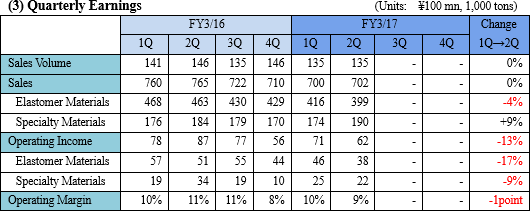 While the positive factor of a rise in sales volumes amounted to ¥1.8 billion, the negative influences of pricing and foreign exchange contributed to ¥0.1 billion and ¥1.5 billion in lower sales respectively. Although higher sales volumes and lower costs were positive factors, pricing, foreign exchange and headquarter expenses were negative factors resulting in a decline in operating profit. 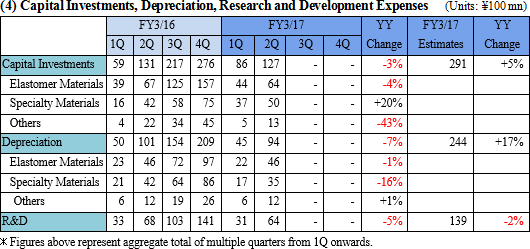 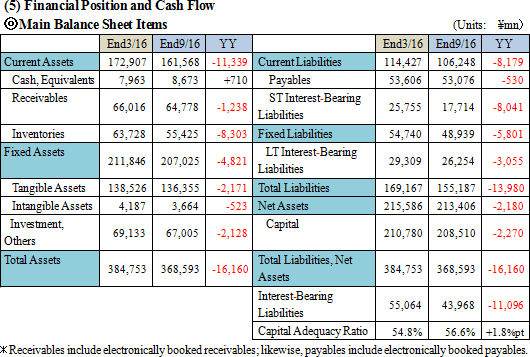 A decline in interest-bearing liabilities caused total liabilities to fall by ¥13.9 billion year-on-year. Shareholders' equity rose on the back of an increase in retained earnings, but net assets fell by ¥2.1 billion year-on-year due to the strengthening in the yen and subsequent foreign exchange adjustment shifting to the negative. As a result, the capital adequacy ratio rose by 1.8% points to 56.6% and interest-bearing liabilities decreased ¥11.0 billion year-on-year. 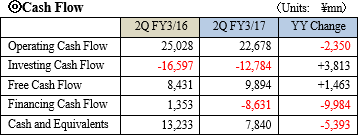 The recovery of loans extended led to a reduction in the net outflow of investing cash flow and an expansion in the net inflow of free cash flow. Along with the repayment of long- and short-term borrowings, the lack of corporate bond issuance resulted in the net inflow of financing cash flow to turn to a net outflow and a decrease in cash position. |
| Fiscal Year March 2017 Earnings Estimates |
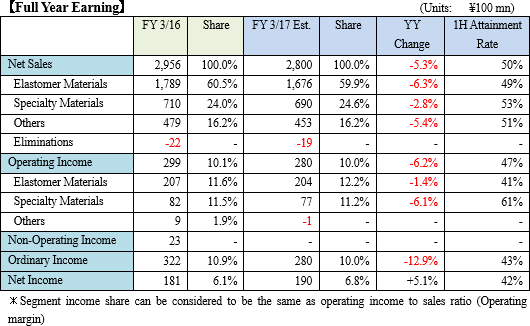  No Changes in Earning Estimates, Sales and Profits Expected to Decline
Zeon maintained its outstanding earnings estimates, which call for sales to decline by 5.3% or ¥15.6 billion year-on-year to ¥280.0 billion during fiscal year March 2017. Both the elastomer material and specialty material businesses are expected to see lower sales due to lower prices and stronger yen, and despite focusing on increases in sales volumes.Operating income is expected to decline by 6.2% or ¥1.9 billion year-on-year to ¥28.0 billion due in part to the effects of the stronger yen (Expected to amount to ¥6.7 billion decline in profits), and despite the positive factors of cost reductions achieved through improvements in manufacturing including strengthened output capacity for thermoplastic elastomer products (Expected to start from July) and start up of the Singapore Plant after the completion of its second-phase construction. Dividends are expected to be raised by ¥1 per share to ¥16.00, for an anticipated dividend payout ratio of 18.7%. |
| Progress in the "New Medium Term Management Plan SZ-20 Phase II" |
|
◎ Positioning of the "New Medium Term Management Plan SZ-20 Phase II"
I believe we can go on to realize the vision of our Company in 2020 as "Zeon makes the Future Today through the Power of Chemistry, Targeting ¥500.0 Billion in Consolidated Sales" by a through review of our traditional methods and thinking to achieve fundamental "changes" to our Company over the next three years.
 ◎ Elastomer Business
◎ Specialty Material Business
◎ Cost Competitiveness Improvements
Along with promotion of strategies in both business divisions, continued aggressive efforts will be made to increase the cost competitiveness of Zeon's businesses.Top-down approaches including intellectual production systems, operations standardization, and work load reductions outlined in the "Production Innovations the Daicel Way" will be implemented, along with bottom-up approaches including cost reductions, circles (Small group activities), cost consciousness training, and other specific themes outlined in the "ZΣ Activities", which have been largely effective in each term until now. 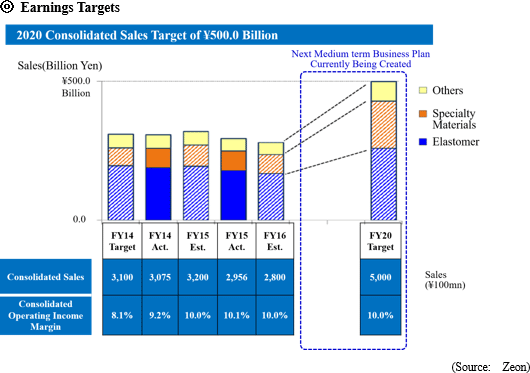 In addition, Zeon will continue to place a high priority upon the values of "speed", "sincerity", and "social contribution", while at the same time working with colleagues in mutual trust and striving to achieve its targets. |
| Conclusions |
|
|
| <Reference: Regarding Corporate Governance> |
 ◎ Corporate Governance Report
The company submitted a latest corporate governance report on July 5, 2016.  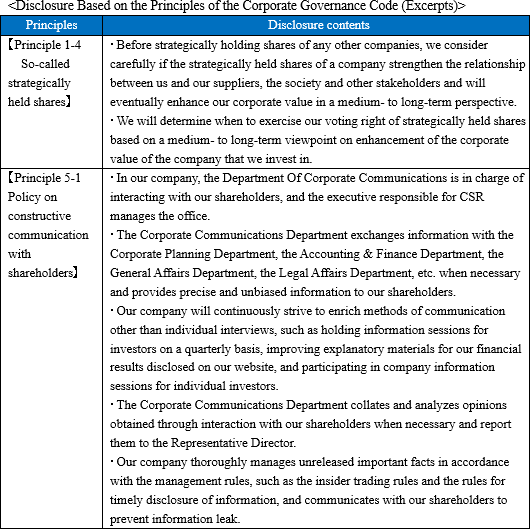 Disclaimer
This report is intended solely for information purposes, and is not intended as a solicitation to invest in the shares of this company. The information and opinions contained within this report are based on data made publicly available by the Company, and come from sources that we judge to be reliable. However, we cannot guarantee the accuracy or completeness of the data. This report is not a guarantee of the accuracy, completeness or validity of said information and or opinions, nor do we bear any responsibility for the same. All rights pertaining to this report belong to Investment Bridge Co., Ltd., which may change the contents thereof at any time without prior notice. All investment decisions are the responsibility of the individual and should be made only after proper consideration. Copyright(C) 2017 Investment Bridge Co., Ltd. All Rights Reserved |
| <Reference: Fact Sheet> |
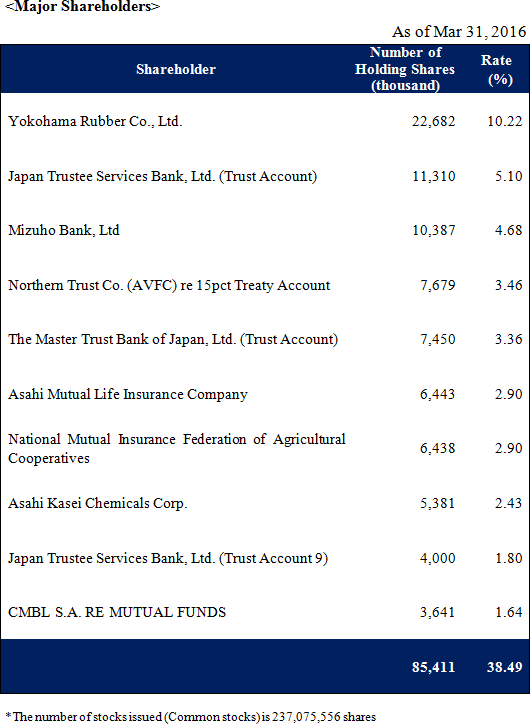 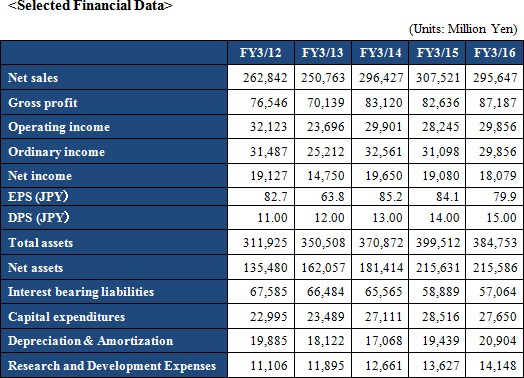 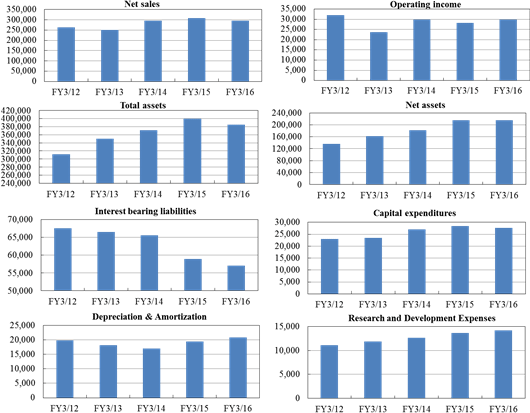 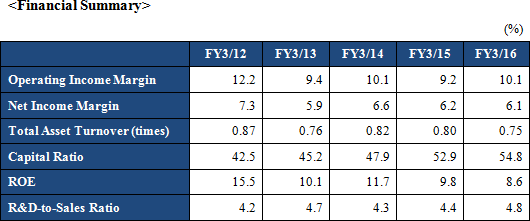 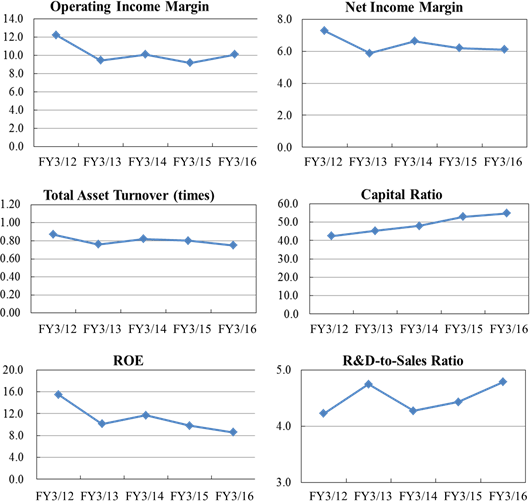 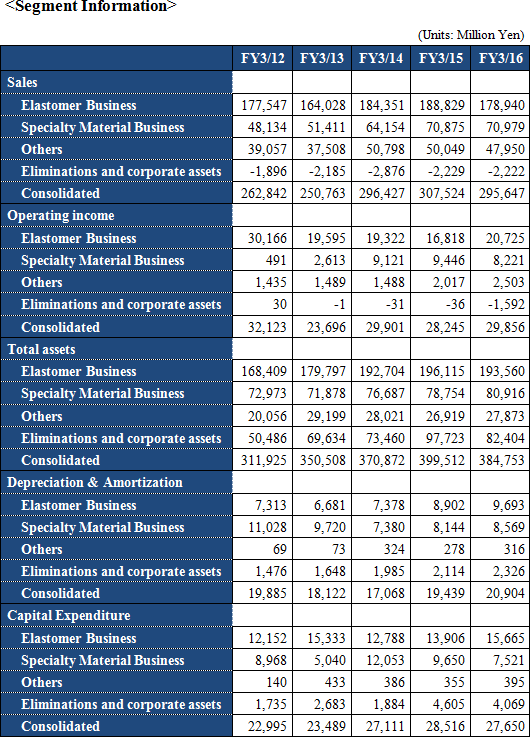 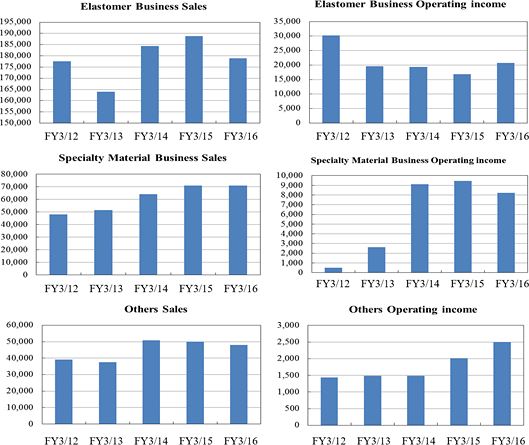 |

